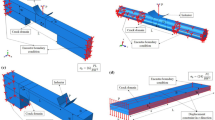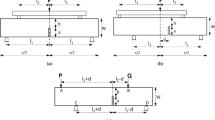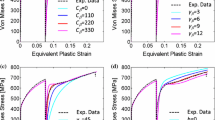Abstract
The objective of this paper is to investigate the implications of the load separation criterion for evaluating ductile fracture mechanics parameters. This criterion allows the load to be represented as the multiplication of two separate functions; a material deformation function and a crack geometry function. Load separation implies a method for J-integral evaluating using only a single load-displacement record. The original method for evaluating J, proposed by Begley and Landes, used the energy rate interpretation of Rice which requires several load-displacement records for identical specimens with varying crack lengths. A method based on load separation introduced a new parameter η, ηel and ηpl which greatly simplified J calculation. This parameter which can be a function of geometrical factors is generally evaluated experimentally using the energy rate interpretation of J.
In this paper the load separation criterion is used to imply a simple method for evaluating η experimentally. Using blunt notched specimen load versus load point displacement results from the literature, four different configurations with a wide range of stationary crack lengths are evaluated. Also included are several different materials varying from low work hardening to high work hardening. The data include thin and thick sections so that both plane stress and plane strain conditions are evaluated. A new method for η-estimation derived from the implication of the load separation is proposed. This method avoids most of the errors that accumulate in the classical methods of estimation. Both the separation method and the energy rate method are evaluated by comparing the techniques and the results. The results show some new trends in ηpl results for the different configurations evaluated in this paper.
Similar content being viewed by others
References
J.R. Rice, Journal of Applied Mechanics 35 (1968) 379–386.
J.A. Begley and J.D. Landes, in Fracture Toughness, ASTM STP 514 (1972) 1–23.
J.D. Landes and J.A. Begley, in Fracture Toughness, ASTM STP 514 (1972) 24–39.
J.R. Rice, Fracture, an Advanced Treatise, 2 H. Liebowitz (ed.), Academic Press (1968).
J.R. Rice, P.C. Paris and J.G. Merkle, in Flaw Growth and Fracture Toughness Testing, ASTM STP 536 (1973) 231–245.
J.G. Merkle and H.T. Corten, “A J-Integral Analysis for the Compact Specimen, Considering Axial Force as Well as Bending Effects,” ASME Paper No. 74-PVP-33 (1974).
J.D. Landes, H. Walker and G.A. Clarke, in Elastic-Plastic Fracture, ASTM STP 668 (1979) 266–287.
J.D.G. Sumpter and C.E. Turner, in Cracks and Fracture, ASTM STP 601 (1976) 3–18.
H.A. Ernst and P.C. Paris, “Techniques of Analysis of Load-Displacement Records by J-Integral Methods,” Nuclear Regulatory Commission, NUREG/CR-1222, January 1980.
P.C. Paris, H. Ernst and C.E. Turner, in Fracture Mechanics, Twelfth Conference, ASTM STP 700 (1980) 338–351.
C.E. Turner in Fracture Mechanics, Twelfth Conference, ASTM STP 700 (1980) 314–337.
D.G.H. Latzko, C.E. Turner, J.D. Landes, D.E. McCabe and T.K. Hellen, Post-Yield Fracture Mechanics, 2nd ed., Elsevier Applied Science Publishers Ltd (1984).
G.A. Clarke and J.D. Landes, Journal of Testing and Evaluation 7, No. 5 (1979) 264–269.
H.A. Ernst, P.C. Paris and J.D. Landes, in Fracture Mechanics: Thirteenth Conference, ASTM STP 743 (1981) 476–502.
V. Kumar, M.D. German and C.F. Shih, “An Engineering Approach for Elastic-Plastic Fracture Analysis,” Electric Power Research Institute, NP1931, Topical Report, July 1981.
Standard Test Methods for JIC, E813-87, and J-R Curves, E1152-87, ASTM Committee E-24 on Fracture Testing (1987).
J.M. Bloom and S.N. Malik, “Procedure for the Assessment of Integrity of Nuclear Pressure Vessels and Piping Containing Defects,” EPRI Final Report NP-2431, June 1982.
J.D. Landes, D.E. McCabe and H.A. Ernst, “Fracture Testing of Ductile Steels', Electric Power Research Institute NP 5014, Final Report of Research Project 1238-2, January 1987.
J.A. Joyce, D.A. Davis, E.M. Hackett and R.A. Hayes, “Application of the J-Integral and the Modified J-Integral to Cases of Large Crack Extension,” NUREG CR-5143, Feb. 1989.
M.H. Sharobeam, “The Geometry and Deformation Function in Ductile Fracture Mechanics and Methodologies,” Ph.D. dissertation, University of Tennessee, in progress.
J.D. Landes, “Analysis of HY130 Steel Fracture Data,” American Welding Institute, AWI 88-0109 (1987).
Author information
Authors and Affiliations
Rights and permissions
About this article
Cite this article
Sharobeam, M.H., Landes, J.D. The load separation criterion and methodology in ductile fracture mechanics. Int J Fract 47, 81–104 (1991). https://doi.org/10.1007/BF00032571
Received:
Accepted:
Issue Date:
DOI: https://doi.org/10.1007/BF00032571




